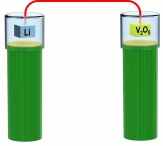Jul 25 2017
Scientists at the University of Maryland have invented a totally new kind of battery. It is bio-compatible because it generates the same kind of ion-based electrical energy used by humans and other living things.
 Credit: University of Maryland
Credit: University of Maryland
In human bodies, flowing ions (potassium, sodium and other electrolytes) are the electrical signals that power the brain and control the heart’s rhythm, the movement of muscles and a lot more.
iIn traditional batteries, the electrical energy, or current, flows in the form of moving electrons. This current of electrons out of the battery is produced within the battery by shifting positive ions from one end (electrode) of a battery to the other. The new UMD battery operates differently. It shifts electrons around in the device to supply energy that is a flow of ions, thus making this ionic current-generating battery the first of its kind to be invented.
“My intention is for ionic systems to interface with human systems,” said Liangbing Hu, the head of the team that created that battery. Hu is a professor of materials science at the University of Maryland, College Park. He is also a member of the University of Maryland Energy Research Center and a chief investigator of the Nanostructures for Electrical Energy Storage Energy Frontier Research Center, sponsored by the Department of Energy, which funded the research.
So I came up with the reverse design of a battery. In a typical battery, electrons flow through wires to interface electronics, and ions flow through the battery separator. In our reverse design, a traditional battery is electronically shorted (that means electrons are flowing through the metal wires). Then ions have to flow through the outside ionic cables. In this case, the ions in the ionic cable – here, grass fibers -- can interface with living systems.
Liangbing Hu, the Head of the Team that created the battery and Professor of Materials Science, the University of Maryland, College Park
The details of the research conducted by Hu and his colleagues have been published in the July 24th issue of Nature Communications.
Potential applications might include the development of the next generation of devices to micro-manipulate neuronal activities and interactions that can prevent and/or treat such medical problems as Alzheimer’s disease and depression. The battery could be used to develop medical devices for the disabled, or for more efficient drug and gene delivery tools in both research and clinical settings, as a way to more precisely treat cancers and other medical diseases, said Zhang, who performed biological experiments to test that the new battery successfully transmitted current to living cells. Looking far ahead on the scientific horizon, one hopes also that this invention may help to establish the possibility of direct machine and human communication.
Jianhua Zhang, PhD, a Staff Scientist, the National Institute of Diabetes and Digestive and Kidney Diseases (NIDDK)
Bio-compatible, bio-material batteries
Since living cells function on ionic current and existing batteries supply an electronic current, Researchers have earlier tried to understand how to form biocompatibility between these two by patching an electronic current into an ionic current. The problem with this technique is that electronic current has to reach a particular voltage to jump the gap between electronic systems and ionic systems. However, ionic currents flow at a very low voltage in living systems. Thus, with an electronic-to-ionic patch the induced current would be too high to function, say, a muscle or a brain. This issue could be eliminated by employing ionic current batteries, which could work at any voltage.
The new UMD battery also has another rare feature –grass is used to store its energy. To create the battery, the team took blades of Kentucky bluegrass and soaked it in lithium salt solution. The channels that once moved nutrients up and down the grass blade were suitable conduits to contain the solution.
The research team’s demonstration battery resembled two glass tubes with a blade of grass inside, each linked by a thin metal wire at the top. The electrons flow through the wire to move from one end of the battery to the other as the stored energy gradually releases. At the other end of each glass tube is a metal tip via which the ionic current flows.
The Researchers established that the ionic current is flowing by contacting the ends of the battery to either end of a lithium-soaked cotton string, with a dot of blue-dyed copper ions in the middle. In the middle of the ionic current, the copper also traveled along the string toward the negatively charged pole, just as the team anticipated.
“The microchannels in the grass can hold the salt solution, making them a stable ionic conductor,” said Chengwei Wang, First Author of the paper and a Graduate Student in the Materials Science and Engineering department at the University of Maryland in College Park.
However, the team plans to branch out the types of ionic current electron batteries they can create. “We are developing multiple ionic conductors with cellulose, hydrogels and polymers,” said Wang
This is not the first time UMD Researchers have examined natural materials in new usages. Hu and his team earlier have been investigating cellulose and plant materials for electronic batteries, developing a battery from a leaf and a supercapacitor out of wood. They also have developed transparent wood as a possibly more energy-efficient alternative for glass windows.
Creative Work
The work is very creative and its main value is in delivering ionic flow to bio systems without posing other dangers to them. Eventually, the impact of the work really resides in whether smaller and more biocompatible junction materials can be found that then interface with cells and organisms more directly and efficiently.
Ping Liu, an Associate Professor in Nanoengineering at the University of California, San Diego
The research was financially assisted by Nanostructures for Electrical Energy Storage, a DOE Energy Frontier Research Center, and by Intramural Research Program of the NIDDK (DK043304).